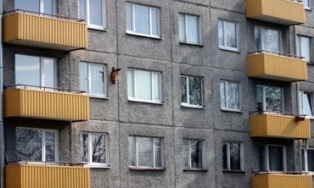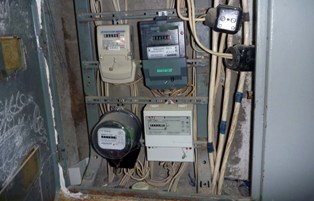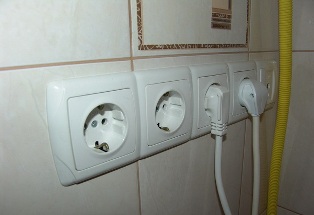Categories: Featured Articles » Electrician at home
Number of views: 54967
Comments on the article: 3
Electrical wiring in a prefabricated house
 At one time, the leadership of our country committed itself to providing each family with a separate apartment. It is clear that before and after that, many different beautiful promises were made, and our state has become completely different. However, they tried sincerely to fulfill the promise about individual apartments. Great hopes in this matter were assigned to the technology of building houses from panels.
At one time, the leadership of our country committed itself to providing each family with a separate apartment. It is clear that before and after that, many different beautiful promises were made, and our state has become completely different. However, they tried sincerely to fulfill the promise about individual apartments. Great hopes in this matter were assigned to the technology of building houses from panels.
Panels are prefabricated reinforced concrete products. At the construction site itself, it remains only to assemble them according to the principle, not far removed from the principle by which children's designers gather.
The technology is really fast, but the same type of panel houses were not the best option for people to live. Low noise insulation, a large level of heat loss, low durability ... But we, in fact, want to talk not about the disadvantages of panel housing. After all, a house is not only building structures. It is also engineering communications.
And we are interested in one of these communications - electrical wiring. And really - to pile the frame from the panels is not at all long and not difficult. But the same wiring should be taken care of in advance. Therefore, the design of the panels provides for grooves and voids designed specifically for installation of hidden electrical wiring.
Thus, a typical technical solution for wiring is as described below.

Housing input 220 volts
In most cases, the meter, introductory switching device and group automatic switches of the apartment in the panel house are located in common areas. Namely - in the entrances. Moreover, switchboards traditionally used in panel houses have a built-in design and can accommodate switching and metering equipment for four apartments. A large number of individual apartments on the floor of a panel house usually does not happen.
Common switchboards are located on each floor exactly one above the other, this allows you to easily power them from the common building switchgear with the help of vertically laid trunk conductors of increased cross section (risers).
If the grounding system of the house is old, TNC (and most often it happens), then there are four riser wires: three phases, to which the apartments are staggered, and zero, common to all and used, among other things, to ground the metal case the shield itself.
In modern prefabricated houses can be used newer grounding system - TNS. In this system, in addition to the three phase and zero working conductors mentioned, a fifth, zero protective conductor is used, which is used to ground live parts, including the shield body.
In some cases, for example, when more than four apartments are located on the site, the opening panel of each apartment of the panel house is individual and located in the apartment itself.
Entrance to the apartment can be performed from a switchgear, located again on the site. But it is also possible when the riser wires pass directly into the wall niche of apartments on each floor.

Thus, to enter a 220 volt apartment in a prefabricated house, the following options are possible:
1. There is no input as such, since the conductors of group lines are stretched directly from the general distribution panel on the site, or the apartment panel is installed directly at the place of laying the riser conductors.
2. The input is a conductor connecting the switchgear on the floor area and the distribution switchboard located in the apartment.
Lighting and outlet lines
For laying these cable lines on the building panels, factory outlets are provided, which greatly facilitate installation. At the construction stage, cable lines are simply laid and fastened in these stubs using a nylon strip, dowel clamps or any other material. For ceiling mounting The internal voids of the floors are used.
The holes in the walls for the installation of switches and sockets can also be factory, and can be performed separately using crowns for concrete and a perforator.
After laying the cables, the finishers come to the apartment, the walls are smeared with the decoration of the walls, the wallpaper is glued, and the cables are completely hidden from view. Wiring in prefabricated houses is almost never open.
The installation of sockets and switches in the apartment of a panel house already has almost no specifics. The only feature: during the construction phase, installation boxes are usually neglected, and sockets with switches are placed on their spacers directly in the holes in the wall.
Subsequently, it often happens that the spreader legs of the sockets can no longer hold the product in the hole, and the socket falls out, especially if the plug is often inserted and pulled out without holding the case by hand.
Cables for connecting ceiling lights and chandeliers are neatly displayed in the holes of the ceilings at a preliminary stage. For fixtures, ordinary dowels with self-tapping screws are used. And chandeliers are most often attached using their own hook, which clings to any element in the void of the ceiling. Often, such an element is an ordinary nested welding electrode or reinforcing bar.

Electric cooker connection line
For the electric stove in Soviet prefabricated houses, special connectors with a high current rating were used. Often these connectors were three-phase in their design. However, real 380 volts for connecting a plate in an apartment of a panel house is a rarity.
Most often, the same 220 volts with a larger cross-section are output to the three-phase connector. Moreover, if the entire apartment is powered by a two-wire system, the line for connecting an electric stove may have an additional protective neutral conductor connected to the body of the input shield.
For laying the cable line of the electric stove, the same shabra and voids in building structures are used as for socket and lighting chains.
Repair and modernization of wiring in a panel house
The most important thing is to remember that you can’t categorically shut down the bearing walls and ceiling. Therefore, as far as possible, it is necessary to open and use the existing walls and voids of the floors.
However, the problem is that the location of these voids and the stub may not suit us at all. And if punching in this situation it is unacceptable or undesirable due to excessive dustiness and laboriousness, and it is necessary that the wiring is still hidden, then there is only one way out: to mount the wiring under the sheathing with sheet material. In this case, the cables are simply mounted on the wall in a corrugated pipe, and then sewn up with sheets of gypsum board, gypsum board or plywood using special guides.
When using the casing, installation and distribution boxes for hollow walls are used: this should also not be forgotten.
If you don’t want to sacrifice the volume of the premises for the sake of cladding, then there is no other way out than at least partially open wiring. Then the best technical solution will be plastic cable ductmounted only on the "problem" site, within which you can’t ditch anything and do not want to sew anything.
Alexander Molokov
See also at bgv.electricianexp.com
:
